


 |
December 5, 2008: Agadir, Morocco |
 |
December 3, 2008: Gibraltar, United Kingdom |
 |
Return to the Europe/Cruise Trip Index |
Docking in Casablanca
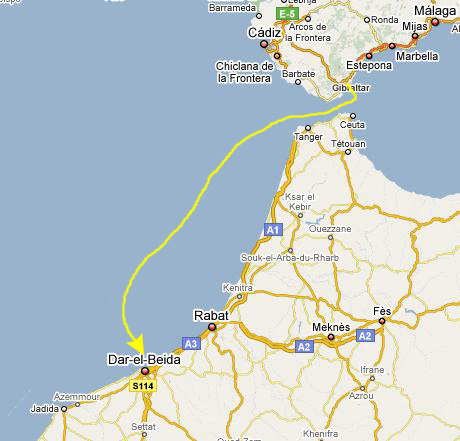 |
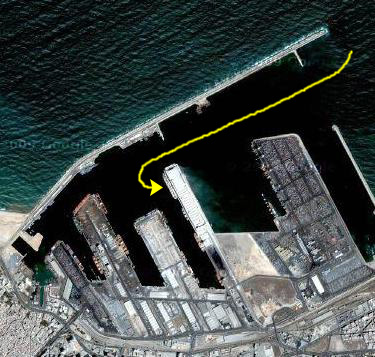
In the aerial view, that's probably not our ship (and certainly not on this morning), but that's where we docked in the harbor. It was a rainy morning, as you can see from the water on the ship rails in this picture of Me on the ship at Casablanca, and we were worried that our shore excursion (a self-guided one) might be rained out. As it turned out, by the time we had breakfast, had disembarked and boarded the shuttle bus that pulled up, it had begun to clear up, and we were able to leave the rain gear on board ship.
One destination that we had read about and that we wanted to get to was the Mosque of Hassan II, one of the largest in the world. You can see the mosque off in the distance in this closeup view taken from the ship. We took some other interesting pictures here in the Casablanca harbor while we were still on the ship, and if you will click on the thumbnail images below, you can have a look at them:

|
|
An Orientation to Casablanca
From the dock, the shuttle took us quite a distance into the city. It traveled down what appeared to be more of an industrial dock that a cruise ship port, took a road along the south side of the harbor, and then turned into the city. It let us off near the Hyatt Hotel. From that central area, we walked westward towards one of the primary marketplaces we'd been told about, and then made our way through that congested area to the Mosque of Hassan II, which is on the ocean at the western end of the city. After touring it, we walked back through the city- a more business and commercial area this time, and back to the shuttle bus stop for our trip back to the ship.
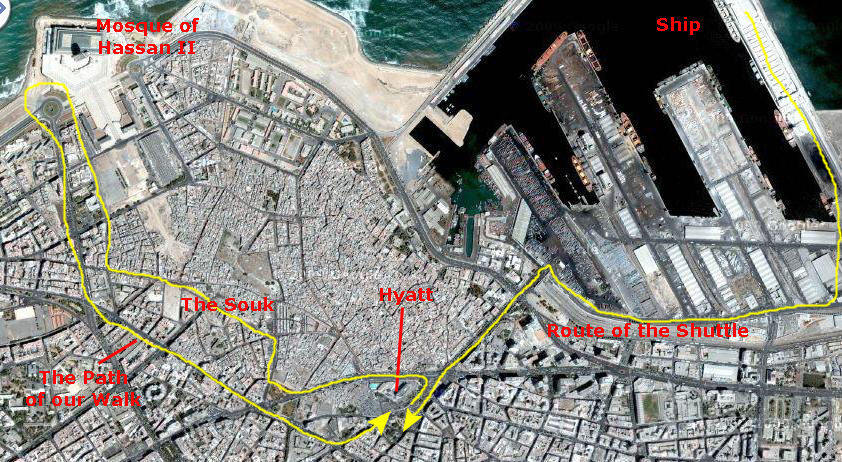
Casablanca is a city in western Morocco, located on the Atlantic Ocean. It is the capital of the Greater Casablanca region. With a population of 3.1 million, Casablanca is Morocco's largest city as well as its chief port. Casablanca is the leading city hosting headquarters and main industrial facilities for the leading Moroccan and international companies based in Morocco. The Port of Casablanca is considered as Morocco's chief port and as one of the largest artificial ports in the world.
The area was settled by Berbers by at least the 7th century. A small independent kingdom, it was conquered by the Almoravids in 1068. During 14th century it rose in importance as a port. In the early 15th century, the town became an independent state once again, and emerged as a safe harbour for pirates and privateers, leading to it being targeted by the Portuguese, who destroyed the town in 1468. The Portuguese used the ruins of Anfa to build a military fortress in 1515.
Between 1580-1640, it was part of Spain, and later it became part of Portugal again. The European Colonists eventually abandoned the area completely in 1755 following an earthquake which destroyed most of the town. The town was finally reconstructed by sultan Mohammed ben Abdallah, the grandson of Moulay Ismail and ally of George Washington. The town was called Dar-el-Beida in Arabic and Casa Blanca in Spanish. Both names translate to "white house."
In the 19th century, the area's population began to grow as Casablanca became a major supplier of wool to the booming textile industry in Britain and shipping traffic increased (the British, in return, began importing Morocco's now famous national drink, gunpowder tea). By the 1860s, there were around 5,000 residents, and the population grew to around 10,000 by the late 1880s. Casablanca remained a modestly-sized port, with a population reaching around 12,000 within a few years of the French conquest and arrival of French colonialists in the town, at first administrators within a sovereign sultanate, in 1906. By 1921, this was to rise to 110,000. In June 1907, the French attempted to build a light railway near the port and passing through a graveyard. Residents attacked the French workers, and riots ensued. French troops were landed in order to restore order, which was achieved only after severe damage to the town. The French then took control of Casablanca. This effectively began the process of colonialisation, although French control of Casablanca was not formalized until 1910. The famous 1942 film Casablanca underlined the city's colonial status at the time- depicting it as the scene of a power struggle between competing European powers, carried out with little reference to the local population.
Casablanca was an important strategic port during World War II and hosted the Casablanca Conference in 1943, in which Churchill and Roosevelt discussed the progress of the war. Casablanca was the site of a large American air base, which was the staging area for all American aircraft for the European Theater of Operations during World War II. Morocco regained independence from France on the 2nd of March, 1956. The city is now developing a tourism industry.
Getting into the City
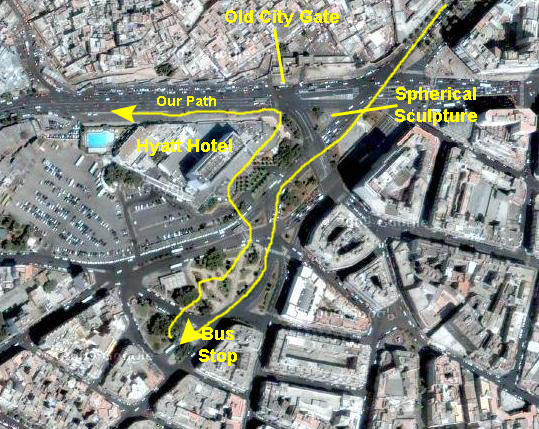 |
But it was ancient in another way; the people seemed as if they'd been plucked from fifty years ago and dropped into this modern milieu. We would occasionally see a horse-drawn cart or even a truck carrying live goats, right in the middle of the city. It was these seeming anachronisms that made the city seem very old instead of very modern. Perhaps that is the attraction of Casablanca, but to me it was a serious drawback, made even more glaring after the cleanliness and modernity of the cities we'd visited so far.
In any event, we wanted to head off towards the one tourist site we planned to visit- the Hassan II Mosque. We could see it in the distance, and so we left the plaza passing one of the gates into the old city.
On the ride into the city on the bus, and just after we alighted downtown, Fred and I took a number of street scene pictures that may give you an idea of what I've been talking about as regards the character of the city. If you will click on the thumbnail images below, you'll be able to take a look at these pictures:
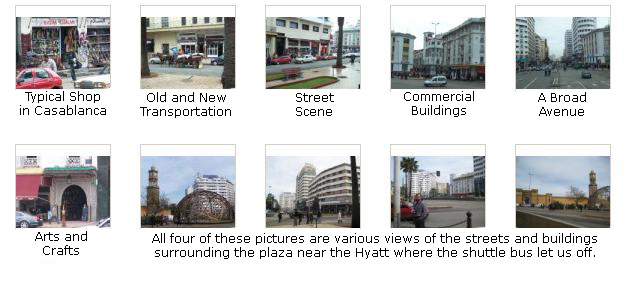
|
|
Walking Through a Souk (Marketplace)
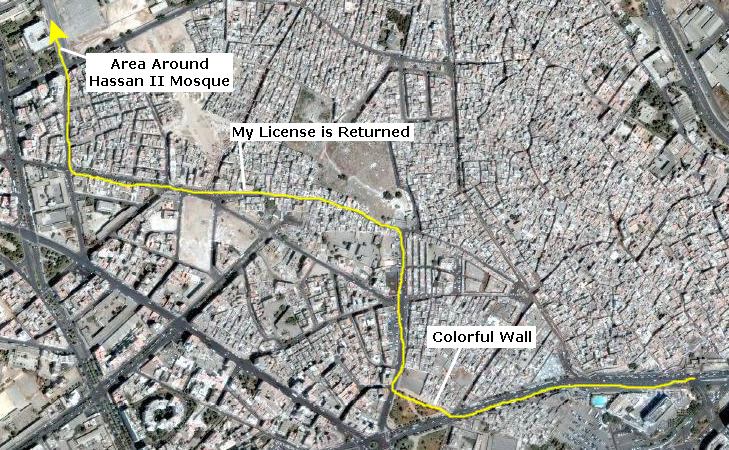 |
I was a little worried that we Americans might be objects of some scorn here in the Arab world, but the people around us, though mildly curious in their glances (as we might be if we saw a group of burkah-wearing women walking in a shopping mall), seemed unconcerned and uninterested. We were accosted only once, and then only by a young teenage boy who simply wanted to return my driver's license, which I had dropped when fishing in my pocket for a camera battery! (Given the look of the souk, that's the last thing I would have expected!)
The souk was really interesting, but then I thought Seoul was immensely interesting too, when I was there forty years ago. As in Seoul, here we found sidewalk card vendors selling everything imaginable- from oranges to bread to prickly pear fruit. In some places we saw buildings that were drab stucco and brick, while in other places someone had made an effort to brighten things up. Because of the upcoming holiday, it seemed that many of the stalls along the streets were selling goats- there must have been hundreds of them in all the various vendor stalls. And, all the way through the old marketplace we saw the continual juxtaposition of the new and the old.
Eventually, we came to the end of the marketplace area and entered the area around the new mosque. Here, the hectic activity of the souk disappeared, and was replaced by streets almost deserted.
We took a number of interesting pictures on our walk to the mosque. If you will click on the thumbnail images below you can have a look at them:
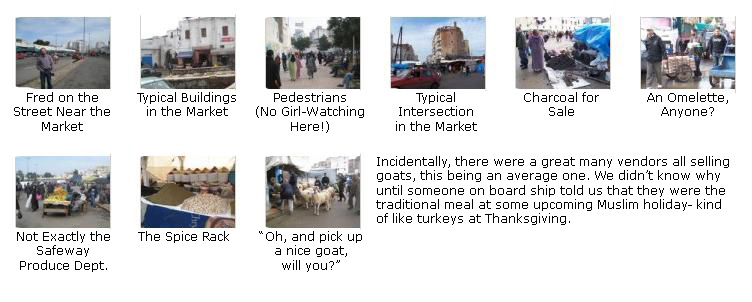
I also took a couple of interesting movies during this part of our walk through Casablanca.
|
|
The Mosque of Hassan II
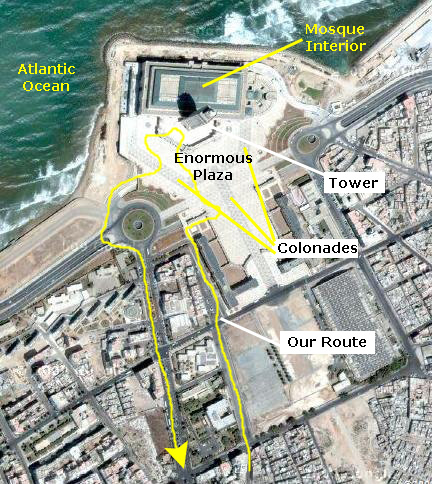 |
Designed by French architect Michel Pinseau, construction of the Hassan II Mosque began in July 1986 on land reclaimed (without compensation to the former residents) from a run-down area near the sea. The goal for completion of the mosque was King Hassan II's 60th birthday in 1989, but it ended up not being finished until August 30, 1993. The project is estimated to have cost as much as $800 million, funds that were remarkably raised entirely from public subscription.
International reports have suggested both local resentment and less-than-voluntary donations to the project, but Moroccans seem to be genuinely proud of their monument and pictures of the mosque are displayed in homes and cafes throughout the country. The massive fundraising also had a positive side-effect: it temporarily reduced Morocco's money supply and brought down inflation. Nearly all the materials of the Hassan II Mosque are from Morocco, with the sole exceptions of the imported white granite columns and glass chandeliers (from Murano, near Venice). The marble is from Agandir, the cedar wood is from the Middle Atlas and the granite comes from Tafraoute.
Over 6,000 Moroccan master craftsmen and artisans were employed to work these local materials into the dazzlingly intricate decorations that embellish the entire structure. When construction passed its deadline in the early 1990s, 1,400 men worked by day and 1,000 worked by night to bring the vast project to completion.
The Hassan II Mosque is open to all Muslims at daily prayer times and for special Friday services. Non-Muslim visitors may only enter the mosque on guided tours, which take place several times a day in English. The most distinctive characteristic of the Hassan II Mosque is its spectacular location (see aerial view at left) on a platform over the Atlantic Ocean. Uniquely, part of the mosque's floor is made of glass so worshippers can kneel directly over the sea. Unfortunately, this wonderful feature is mainly for royal use and is off-limits to visitors. Above, an automated sliding roof opens (on special occasions) to the heavens. Thus the faithful of Casablanca can indeed contemplate God's sky and ocean in accordance with Hassan's wishes.
We could have signed up for one of the tours that takes you into the mosque and, in retrospect, we probably should have done so, but we had not known of the tours at the time we left the ship on our own. So we missed the inside of the mosque entirely. But I didn't think that my narrative here would be complete without recording what the inside actually looked like- if not just for my own edification but for you, the reader. So, I have found a Website that has some good pictures of the inside features of the mosque, and I am going to borrow some of them. Here are some of those pictures:
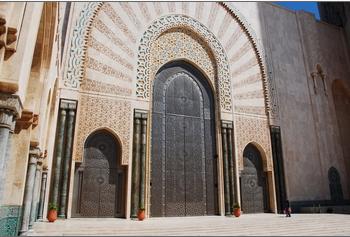 One of several sets of entrance doors to the mosque |
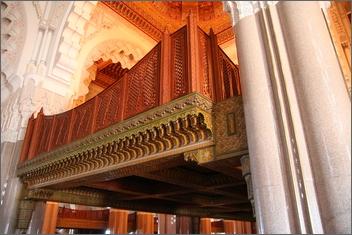 The first sight as you enter is this spectacular women's gallery |
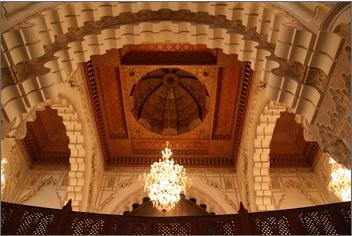 Intricately carved ceiling above the women's gallery |
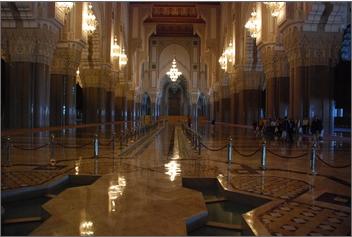 General interior view, with glass floor overlooking the baths below |
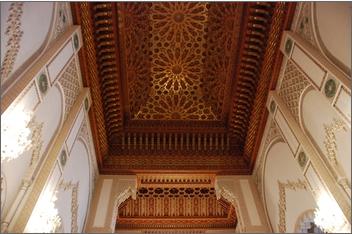 Finely carved wooden ceiling |
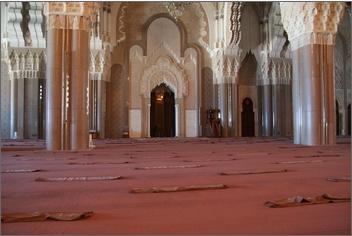 Prayer area, with small rugs ready to hold shoes |
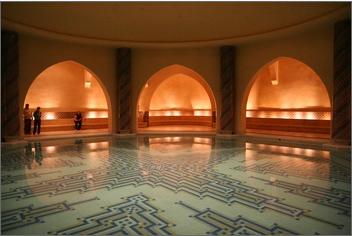 Large communal bath beneath the mosque |
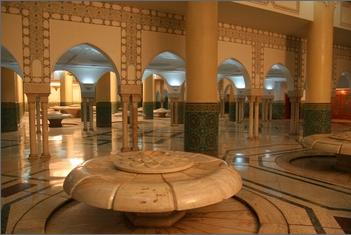 Fountains beneath the mosque |
Outside the mosque, there was an extensive area of support buildings that you can see in the aerial view to the southeast of the mosque itself. Even these buildings were intricately designed and constructed, although it seemed that work was still going on. Of course, one of the most spectacular features of the mosque was the huge plaza on the east and south sides of the mosque. I suppose such an area is necessary, since the mosque can hold about 30,000 worshippers at a time. The plaza on the ocean side (the south side of the mosque) was particularly beautiful (as was the view from it).
|
We took a number of excellent pictures around the courtyard and outside the mosque, and it was hard to discard very many of them as not being worthy of including here. The construction and ornamentation were exquisite; it was quite evident that much care and much effort went into the building. As one might expect with a structure so large and so important and on which so much money was lavished, the decorative arts were put to excellent use at the Hassan II Mosque. In every area we visited, the attention to the decorative details was quite amazing. Fred, as usual, took a number of pictures to try to illustrate the extent of this detail. The 35 pictures I've selected of the mosque are, I think, self-explanatory, so I've put them into a slideshow. The slideshow will have two sections. The first group of 25 or so pictures are of the mosque itself, and the last section of ten or so focus on the decorative detail that interested both Fred and I so much.
To view the slideshow, just click on the image above, left and I will open the slideshow in a new window. In the slideshow, you can use the little arrows in the lower corners of each image to move from one to the next, and the index numbers in the upper left of each image will tell you where you are in the series. When you are finished looking at the pictures, just close the popup window.
Below are the movies that I made while we were here at the Hassan II Mosque:
|
|
|
|
Walking Through the City
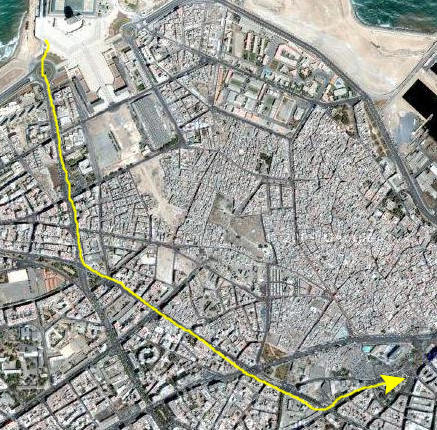 |
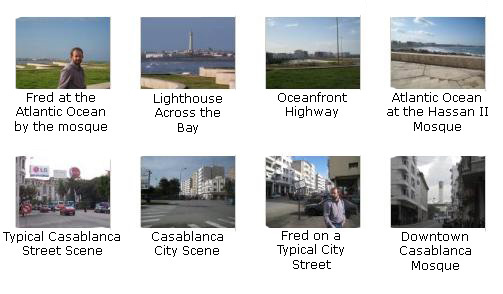
When we got back to the shuttle bus stop, there was no bus waiting so we had to hang out for a while. We took a few more pictures of the activity around the plaza where the bus stop was, and you can click on the thumbnail images below to see these pictures:

Eventually, the shuttle bus arrived and we hopped on for our ride back to the ship.
Returning to the Ship

It was a pretty good afternoon in Casablanca, although I must admit that I'd expected something different. But all in all it was an interesting walk.
The ship sailed right on time about 6PM, heading off the short distance to our stop for tomorrow- Agadir, Morocco.
You can use the links below to go to another photo album page.
 |
December 5, 2008: Agadir, Morocco |
 |
December 3, 2008: Gibraltar, United Kingdom |
 |
Return to the Europe/Cruise Trip Index |